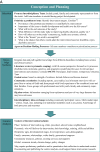Building a Life Course Intervention Research Framework
- PMID: 35503325
- PMCID: PMC9847427
- DOI: 10.1542/peds.2021-053509E
Building a Life Course Intervention Research Framework
Abstract
Objectives: To report on first steps toward building a Life Course Intervention Research Framework (LCIRF) to guide researchers studying interventions to improve lifelong health.
Methods: The Life Course Intervention Research Network, a collaborative national network of >75 researchers, service providers, community representatives and thought leaders, participated in an iterative review process. Building on the revised Medical Research Council Guidance for Developing and Evaluating Complex Interventions, they identified 12 additional key models with features for inclusion in the LCIRF, then incorporated the 12 characteristics identified by the Life Course Intervention Research Network as actionable features of Life Course Interventions to produce the new LCIRF.
Results: The LCIRF sets out a detailed step-wise approach to intervention development: (1) conceptualization and planning, (2) design, (3) implementation, (4) evaluation, and (5) spreading and scaling of interventions. Each step is infused with life course intervention characteristics including a focus on (1) collaborative codesign (2) health optimization, (3) supporting emerging health development capabilities (4) strategic timing, (5) multilevel approaches, and (6) health equity. Key features include a detailed transdisciplinary knowledge synthesis to inform intervention development; formation of strong partnerships with family, community, and youth representatives in intervention codesign; a means of testing the impact of each intervention on biobehavioral processes underlying emerging health trajectories; and close attention to intervention context.
Conclusions: This first iteration of the LCIRF has been largely expert driven. Next steps will involve widespread partner engagement in framework refinement and further development. Implementation will require changes to the way intervention studies are organized and funded.
Copyright © 2022 by the American Academy of Pediatrics.
Conflict of interest statement
Figures



References
-
- Halfon N, Forrest CB. The Emerging theoretical framework of life course health development. In: Halfon N, Forrest CB, Lerner RM, Faustman EM, eds.. Handbook of Life Course Health Development. Cham, CH: Springer; 2017:19–43
-
- Anderson PM, Butcher KF, Schanzenbach DW. Understanding recent trends in childhood obesity in the United States. Econ Hum Biol. 2019;34:16–25 - PubMed

